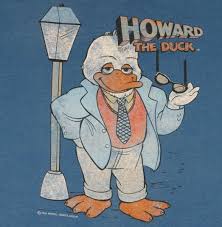Its about time, its about space, its about being lost in time. Nightmares, jokes and laugh, bumps in the road, dances in the dark. Dicks, dawgs, witches with skill, earth angels, the kids and goats, love and hate, horns to sound. Love and hate, horns of a goat, light and darkness, hits and misses, pages in a book: notes of donkeys tales, good times. Angels to call, angels in hosts, angels in all of us, night and day, joys and pains, lovers and dawgs., dicks and lovers on the down low.
marvel.wikia.com/wiki/Howard_the_Duck_(Earth-2149)
Little is detailed about Howard's life before the zombie plague arrived on ... the Ashley J. Williams of Earth-818793, and finally killed by Scarlet Witch's magic ... The zombified Howard the Duck of Earth-2149 first appeared in Marvel Zombies vs ...
ENGLISH words,…Dense For Life: Tricks. BOLD TIME.😨 comment "BOLD" and ill inbox you something i always wanted to tell you.💯🌞🌙.Life as an adventure better shared for trips of a new lifestyle to create from ashes of life over and done. Only once in a lifetime, trapped in a den of snakes, crooks and robbers. Horse and pony shows, dances in the dark, stuck in a coffin, eaten alive. Clowns and fags, jokers and frogs, dates on the beach.
The American Bar Association (ABA) Commission on Homelessness and Poverty offers technical support. For information, please contact Amy Horton-Newell at the ABA Washington Office at (202) 662-1693 or via e-mail at homeless@abanet.org. The ABA has also developed approved policies related to homeless courts, including basic principles for homeless court programs, which may be found at The American Bar Association: Commission on Homeless and Poverty website.Dicks, Dawgs, Donkey Dates, Dung, And Fecal Matter, Faces Of Frogs, Plenty Of Fish.
Windows, Doors, Open Wide, Ships To Sail, Boats To Float, Cowboy Games. Sending lots of love your way . The purpose of life is to live it, to taste experience to the utmost, to reach out eagerly and without fear for newer and richer experience." ― Eleanor Roosevelt . To do list •Play with fairies •Grow Angels wings •Braid the hair of mermaid •Fly to the Moon.Guys Reasons why you should get dewormed regularly please RT and save a life TARKAA, Moses Kator

Just a moment, lost in time, reasons to love, hate, recap, review, pages to books, read, rites, and homeless blues, American rites, songs to sing, glory dazes to come. Happy Friday, make it a blast, in and out of the lights, sons to shine, Starr Bright, Happy Dazes to share, hats and horns, love and hate, sheep and goats, animals under the skin. Hallelujah and Gods Good Morning to You And Yours...Today im Sharing alil Backwards... Questions One May ask SELF Consider While Reading. Smiles and Blessings Ms.Tamu Martin...Thanks for the moments that you share, the shot,the song, the prayer from you to me. Happy Friday, strangers to friends, online, heads or tales, coins to flip. Starr Bright, Happy Dazes, good times, sons to shine, thanks again. Happy and sad, tired and heavy eyes, watch Younger online, late last night.

These books use to give many of nightmares growing up! RACHEL JARROT- SHE IS A UGLY BALD BITCH...Former Employees Call Trump University a "Façade" That "Preyed Upon the Elderly and Uneducated: Love the show, all the hits and misses, cartoon nuts to go. Bugs Bunny, and the loony tunes. Frank and nuts, Franky Trees, nuts to fall, nuts to grow, 6 nuts, and two bitches, for cows. Retards, rejects, escapees, basket cases, lots of laughs, from NY. Rotten apples, all of time, dicks, dawgs, and donkeys to date. Pages to books, recaps, recalls, reviews, of the cartoon hits, nuts from NY.Role Models, Big And Great, Green Eyes, Third Set, Open Wide. Dances For Fame, Pages To Books.The BEST BUGS BUNNY, DAFFY DUCK & PORKY PIG: Looney Tunes Merrie Melodies [Cartoons For Children HD].
🍭🍭. 💗🐹🍰💦💦.Fairy Tales: Running with angels, goodness and mercy angels on earth, Hares Lost In Woods: ☠....Battles And Wars Won: Life Is A Beach, A Mountain. A River.Choose your class: Earth Angels: Birds in the sky, black as knights, crows to the rounds, circles of life, luck, love, lessons, leaders in the wings, dances on time, notes in the air.
Just a moment, lost in time, reasons to love, hate, recap, review, pages to books, read, rites, and homeless blues, American rites, songs to sing, glory dazes to come. Happy Friday, make it a blast, in and out of the lights, sons to shine, Starr Bright, Happy Dazes to share, hats and horns, love and hate, sheep and goats, animals under the skin. Hallelujah and Gods Good Morning to You And Yours...Today im Sharing alil Backwards... Questions One May ask SELF Consider While Reading. Smiles and Blessings Ms.Tamu Martin...Thanks for the moments that you share, the shot,the song, the prayer from you to me. Happy Friday, strangers to friends, online, heads or tales, coins to flip. Starr Bright, Happy Dazes, good times, sons to shine, thanks again. Happy and sad, tired and heavy eyes, watch Younger online, late last night.
https://www.youtube.com/watch?v=h6HgmlBgqBk
Dec 13, 2017
100% completing heroic mode in Howard the duck event. Only using a 3* scarletwitch. Plus the nice rewards :)
Missing: mermaids
https://www.themarysue.com/things-we-saw-today-1346/
Nov 3, 2017 - ... totally had several options when it came to her contract with Ursula the Sea Witch. ... I'm calling for another Howard The Duck appearance.
Once long ago, man and woman, had a life, this is the shot, to remember of the blessed event, happy days done. Lovers and haters, goats and sheep, bumps in the road, married life. Gifts of love, gifts of goats, gifts of sheep, gifts of love and hate, kids and goats, horns. Dances in the dark, dances in the rain, happy for the love of a man. Love for a woman, family created, two hearts together, two as one. Happy Notes, Angels To Spare, Happy Birthday greetings, Bob Marley, day of his birth, February 6.
RACHEL JARROT- SHE IS A UGLY BALD BITCH...Former Employees Call Trump University a "Façade" That "Preyed Upon the Elderly and Uneducated: Once long ago, man and woman, had a life, this is the shot, to remember of the blessed event, happy days done. Lovers and haters, goats and sheep, bumps in the road, married life. Gifts of love, gifts of goats, gifts of sheep, gifts of love and hate, kids and goats, horns. Dances in the dark, dances in the rain, happy for the love of a man. Love for a woman, family created, two hearts together, two as one. Happy Notes, Angels To Spare, Happy Birthday greetings, Bob Marley, day of his birth, February 6, 2017.

It's Going Viral For One STUNNING Reason. 😕😕😊😊😔😔😌😌.Cartoon hits, cartoon shows ,kids to watch, laughs tonight, good times. Aurora Agresti, Jose A Santiago. Classes on love and devotion, goodness and mercy, angels to see. It appears some mental issuers? 😎👍🌊🏄 Frank Agresti Elaine SchiavoneSailor-stars, new to me, never had the time to stop.
Veterans Housing Matters: Houses with heat, houses without bed bugs, houses that are not churches, homeless bues for homeless veterans. Hands out to help, hands out to lead the way, hands out for keys to new houses, and new homes, dreams right now.Marne, Iowa: Veterans Housing Matters: Houses with heat, houses without bed bugs, homeless blues.another day. ..WavesTo Make. "you think I give a fuck?Snakes in Grass Snakes And Worms.     ... |
Stores of Tips:Role Models, Big And Great, Green Eyes, Third Set, Open Wide. Dances For Fame, Pages To Books. American Veterans. Earth Angels In Lights: Bitches 5 Stars, Dames, unfuckwithable:The BEST BUGS BUNNY, DAFFY DUCK & PORKY PIG: Looney Tunes Merrie Melodies [Cartoons For Children HD].
11 Famous Mermaids and their Creators

AMERICAN MUSEUM OF NATURAL HISTORY
Mythology is rife with creatures that mix traits of the familiar and the fantastic. Maybe it’s because they resemble us, but half-human legends from werewolves to centaurs have been mesmerizing staples of world mythologies for thousands of years. Particularly alluring is a certain half-woman-half-fish that entices sailors and sea captains with her singing and curvaceous bod. Mermaids have appeared in Polynesian, Celtic, Middle Eastern, and Japanese mythology for centuries, and have swum into popular culture through folk tales, literature, song, and even the silver screen. From Ariel to the Sirens, here are 11 bewitching examples of what you get when you cross a fish and a pinup girl.
1. Hans Christian Andersen’s Little Mermaid
MORE FROM MENTAL FLOSS STUDIOS
POP CULTURE
Real Dragon Eggs
Getty Images
Perhaps the most famous mermaid is the title nymph of the fairy tale by
Hans Christian Andersen, who risks her life in order to follow the shipwrecked human prince she loves onto land. Originally conceived as a ballet, the Danish author’s children’s story appeared in 1837; the original tale includes such elements as the little mermaid’s beloved grandmother, who “was a very wise woman…[who] wore twelve oysters on her tail,” and the exchange of the princess’s tongue for a pair of human legs from an evil sea witch. When her human lover marries someone else, Anderson’s mermaid is unable to return to her underwater kingdom and evaporates into sea foam. A statue of her by sculptor Edvard Erikson sits on a rock in the Copenhagen harbor.
2. The Sirens
One of the earliest records of bewitching sea-women appears in the
Odyssey, where Odysseus, the hero of Homer’s epic poem, is warned by the sorceress Circe about the sirens whose singing lures sailors to a grisly death shipwrecked on the rocks. Odysseus convinces his crew to stuff wax in their ears so that the mesmerizing song won’t affect them, but has himself tied to the mast and more or less goes ballistic listening. The earliest ceramic paintings depict the sirens as
women with the wings of sparrows, but in later folklore this image was changed to one closer resembling a modern mermaid (as in the 1909 painting by Herbert James Draper, above). The word itself survives in the Latin root for the words for mermaid in languages such as Italian (
sirena) and French (
sirene).
3. Howard Pyle’s The Mermaid
Nineteenth century artist and illustrator
Howard Pyle was a celebrity in his time for his illustrations in
Scribner’s and
Harper’s Monthly magazines and for his vivid paintings of King Arthur, Robin Hood, and other exotic rogues and heroes featured in his numerous children’s books. He invented our modern visual concept of a
pirate, and inspired such artists as Norman Rockwell and Hal Foster, the creator of the
Prince Valiant comics. Pyle’s mermaid is a standalone example of his work in the golden age of American illustration. Though it appears complete, the 1910 painting was left on the easel prior to the artist’s last trip to Europe, and only partially finished by a student after he passed away in Florence.






No comments:
Post a Comment